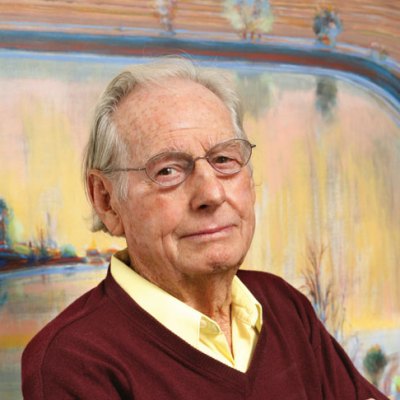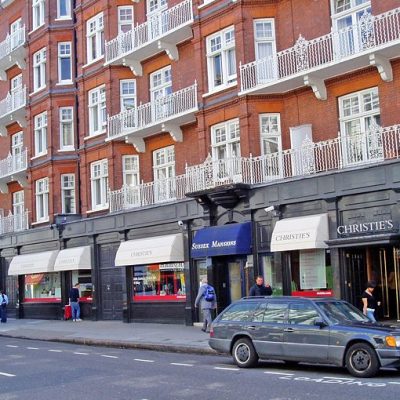In today’s brave new world of alternative facts, sales of George Orwell’s dystopian 1984 have reportedly soared. For this year’s Frieze Masters art fair (5–8 October), now in its sixth edition, Galerie Thaddaeus Ropac plans a booth based around the novel, bringing a selection of works from its titular year that offer an alternative view to Orwell’s gloomy vision. ‘It was a very fertile year for artists, and the works have an exuberance, energy and sense of optimism,’ says gallery director Polly Robinson Gaer. The booth will include works by Gilbert & George and Richard Deacon, both nominated for the Turner Prize that year, as well as Georg Baselitz, Robert Rauschenberg, and Robert Mapplethorpe (booth range £100,000–£3m).
Their themed booth ties in with Frieze Masters’ offering of more measured and thoughtful presentations of older art among its 140 carpeted booths, keeping the fair distinct from its contemporary counterpart on the other side of the park. Ever since 2014, when London’s Helly Nahmad gallery brought a show-stopping recreation of a fictional collector’s apartment to Frieze Masters’ third outing, an increasing number of exhibitors have got creative, often inviting outside curators and designers to shape the theme of a booth that only stands for a few days.
Party 1 Sing Song (1985), Peter Blake. Waddington Custot

This year is no exception. As well as Thaddaeus Ropac’s homage to 1984, Waddington Custot will recreate the west London studio and living space of British Pop artist Peter Blake. The gallery promises open-brick walls and floating windows with books, photographs, and Blake’s own wrestling memorabilia in its booth for which the artist, now 85, has collaborated with designer Robin Brown and art-to-fashion producer Anna Pank (both also behind Helly Nahmad’s fictional collector). Works loaned by private collections will be on view, as well as some pieces for sale – this is an art fair after all. Two trademark collages – Party 1: Sing Song (1985) and Party 2: A Party with La Giaconda (1985) – are offered for £26,000 and £28,000 respectively. Blake is also participating in a conversation with fellow artist and curator Colin Wiggins during the fair.
London’s Luxembourg & Dayan, in collaboration with Gió Marconi gallery, has a similar theme in mind for an artist likely less known to UK crowds: a recreation of the north Italian home of Enrico Baj, who died in 2003. The gallery describes Baj’s works as ‘profoundly imaginative, with a penchant for the absurd’ and brings works from his admired Generals and Ladies series for which he added ribbons and other decorations to portraits, often to farcical, pointed effect (works range from €50,000 to €250,000). The booth will also include cushions that Baj embroidered among the domestic fare. Roberta Baj, the artist’s widow, is consulting on the project.
Femme Assise (1966), Enrico Baj. Luxembourg & Dayan

It all contributes to an educational feel at a fair that was launched to encourage contemporary art buyers to cross over into older art that they perhaps understand less. The higher-than-average number of solo booths add to the effect – Blain|Southern homes in on French conceptual artist Bernar Venet; Almine Rech brings drawings by Tom Wesselmann; New York’s Cheim & Read joins up with London’s Thomas Dane to show feminist artist Lynda Benglis. There’s also the Spotlight section of 21 solo presentations, again curated by Toby Kamps, which aims to bring lesser-known 20th-century artists into the canon. Highlights here include the Beijing-based, Bulgarian textiles artist Maryn Varbanov (Bank); the self-taught, deaf-mute, Idaho artist James Castle (Fleisher/Ollman Gallery) as well as works from the 1970s and ’80s by the better-known Chilean artist Alfredo Jaar (Galerie Lelong and Goodman Gallery).
It can’t be ignored that the above all fall squarely into the 20th-century field, at a fair whose name suggests works from earlier times. Indeed, of the 110 exhibitors in the main section of the fair, around 60 per cent are 20th-century specialists, while Old Masters dealers are rather in the minority. It’s something that organisers are fully aware of, says deputy director Nathan Clements-Gillespie, though the balance is in keeping with an aim to encourage cross-collecting: ‘Some contemporary collectors feel more out of bounds with antiquities and Old Masters, though that doesn’t stop the fair from being historical and leading the way to older art.’ Plus there are plenty of highlights from earlier periods, he says. Dutch Old Masters stand out, including newly discovered works by Jacob Jordaens and Simon Luttichuys, brought by the Amsterdam and Geneva gallery Salomon Lilian, and 15th-century astronomical and pharmacological texts by another Dutchman, Henricus Spijker, brought by Dr Jörn Günther Rare Books. Stretching further back, Ariadne Galleries has an Egyptian bronze Apis bull, with electrum eyes and hieroglyph inscriptions. The Collections section of the fair, which allows more niche areas to come to the fore, includes Andean textiles from 200 BC to 1500 AD (Paul Hughes Fine Arts).
Der Bote (1984), Georg Baselitz. Thaddaeus Ropac

The fair has also joined forces for the second year running with the Art Fund Curators Programme and London’s National Gallery to bring 20 museum curators – half from the UK and half from overseas – for a one-day conference and networking event on 5 October that this year focuses on how to turn contemporary eyes to Dutch Old Masters. The event, supported by the Art Fund, was well received last year and has since doubled its delegates. Attendees this year include curators from the Rijksmuseum (whose general director, Taco Dibbits, opens the day), the Frans Hals Museum in Haarlem, the Fitzwilliam Museum, and Norwich Castle Museum & Art Gallery. The initiative ‘gets a good group of younger curators into Frieze Masters, which facilitates buying’, Clements-Gillespie says, adding that last year the Metropolitan Museum of Art acquired a piece of tribal art partly through the curator on the Art Fund’s programme. Clements-Gillespie says: ‘It isn’t just about acquisitions, it gets people who might not otherwise have a travel budget to talk to each other.’
Dealers are of course hoping to get a few museum curators on to their booths. ‘All fairs claim they attract museum curators, but we don’t always see them, they get hijacked immediately,’ says Benedict Tomlinson, director at Robilant + Voena. The gallery is bringing a solo show – of the Italian post-war sculptor Pietro Consagra – within a booth themed around paintings of David and Goliath. ‘Of course, we also want to see big collectors,’ Tomlinson adds.
Frieze Masters is at Regent’s Park, London, from 5–8 October.
From the October 2017 issue of Apollo: preview and subscribe here



